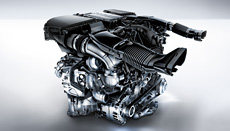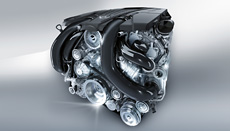
| Model | Cylinder arrangement and number | Engine displacement (cc) | Rated output (kW at rpm)[1] | Top speed (km/h) | Fuel consumption combined (l/100 km)[2] | CO2 emissions combined (g/km)[2]) |
|---|---|---|---|---|---|---|
| E 200 | I4 | 1991 | 135/5500 (135/5500) | 235 (235) | 6.5–6.4 (6.4–6.1) | 152–150 (148–142) |
| E 250 | I4 | 1991 | – (155/5500) | – (245) | – (6.5–6.2) | – (150–144) |
| E 300 | V6 | 3498 | – (185/6500) | – (250)[3] | – (7.5–7.2) | – (175–169) |
| E 350 | V6 | 3498 | – (225/6500) | – (250)[3] | – (7.5–7.2) | – (175–169) |
| E 400 | V6 | 2996 | – (245/5500) | – (250)[3] | – (7.9-7.6) | – (185–178) |
| E 500 | V8 | 4663 | – (300/5000-5750) | – (250)[3] | – (9.1) | – (213) |
Optimised performance along with improved consumption figures.
[1] Figures for rated power output and rated torque in accordance with Directive 80/1269/EEC in the currently applicable version.
[2] The figures shown for fuel consumption and CO2 emissions were obtained in accordance with the prescribed measuring process (Regulation [EC] 715/2007 in its currently applicable version). The figures are not based on an individual vehicle and do not constitute part of the product offer; they are provided solely for purposes of comparison between different vehicle models
[3] Electronically limited





